Marketplaces feed management
MARKETPLACES FEED MANAGEMENT
Maximize your presence on marketplaces while minimizing the time spent
LIST YOUR PRODUCTS
AN ULTRA FLEXIBLE AND POWERFUL FEED MANAGER
UPDATE YOUR STOCKS
FAST AND RELIABLE STOCK MANAGEMENT
AUTOMATE
AUTOMATION
Choose a “Platform” type feed manager
When it comes to marketplace feed management, all feed managers are not created equal. Feed managers of the “Platform” type, like Sellermania, go further than pure feed management, and add advanced features to perform on marketplaces. These are two different ways of looking at selling on marketplaces. Learn more about these differences.
Our 15 years of experience in marketplaces has enabled us to adapt our platform to enable the merchant’s success on marketplaces : feed, synchronization of stocks, orders, pricing, matching …
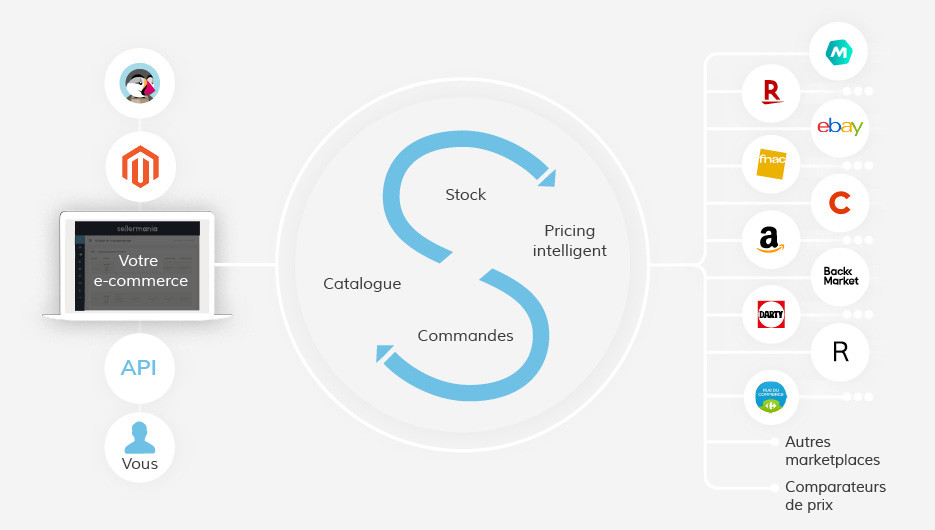

Adapt your product feed automatically
Flexibility: The Sellermania Mapper is a feed management software, patented solution, which allows you to adapt your file or feed to the finest requirements of all marketplaces. See the Mapper as a gigantic macro, which will transform your data to match marketplace’s categories, map your product attributes to marketplaces’ requirements, clean up your catalog, until it is exactly compatible with the marketplaces.
The power of the Mapper allows, with its 50 tailor-made functions, to adapt to almost any situation and send your product feed to marketplaces, shopping engines, retargeting …
Our marketplace management tool is comprehensive, adaptable and easy to use.
Matching and product creation
Whether your products are already listed on marketplaces (matching) or not yet (creation), Sellermania’s software allows you to easily list your catalog, thanks to its marketplace feed management solution.
If you do not own a feed, you can easily list your items directly from the interface. “The EAN finder” immediately shows you the product reference number on each marketplace.
The creation’s second to none flexibility enables to adapt to virtually any case, whether you have one or more feeds.
Our marketplace management tool saves companies precious time.
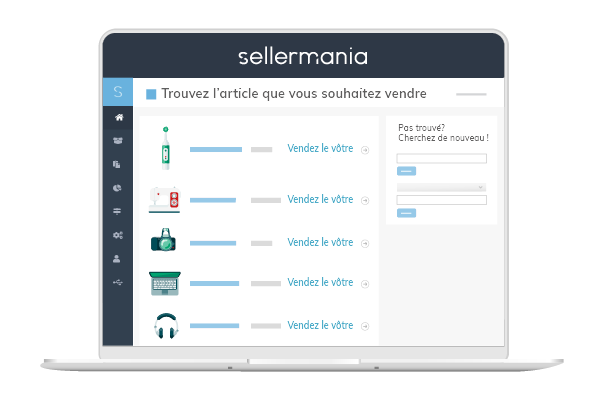
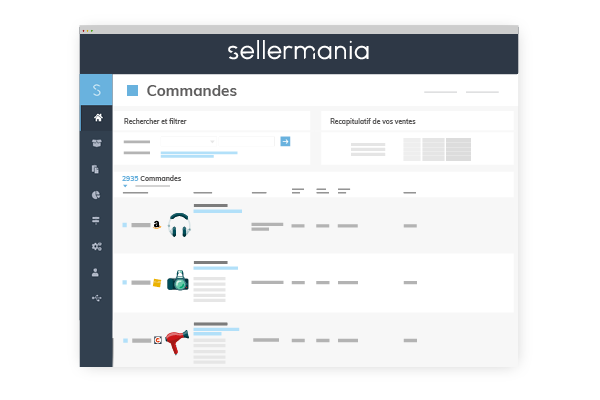
With or without website
If you have a website , you can easily connect it to Sellermania, so that products added to your site are automatically transmitted to marketplaces. Stocks are constantly synchronized between your site and all marketplaces.
If you don’t have a site , consider Sellermania as a multi-marketplace “Seller Central” one-stop shop. The interface allows you to easily manage all your marketplaces activity: adding products, managing stocks, managing orders, importing / exporting files, etc.
Automate and save time
Automate inventory updates, prices, file uploads and exports. Sales made on one marketplace automatically reduce inventory on all other marketplaces. As a result, your stocks are up to date everywhere.
Automatically retrieve orders from your website, export them to your logistics, automatically transmit order tracking numbers.
Our APIs allow you to fully automate the sales cycle, in real time. Our marketplace management tool can easily automate time-consuming tasks.
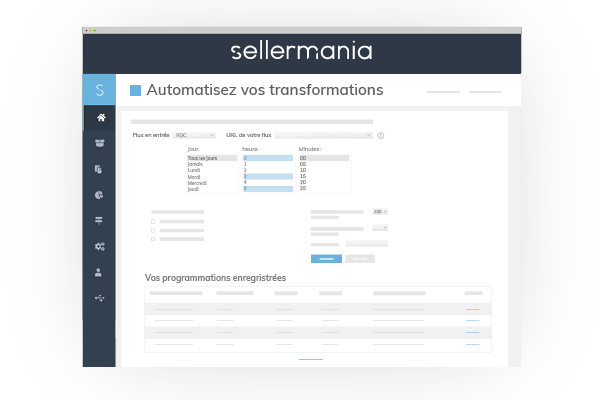
Widget Title
Why a feed manager is so important ?
It depends on the software you use. The criteria to set the repricing tool can be very different from a repricing platform to the next. If you work on Sellermania’s platform, you can set up a strategy, based on several criteria other than your selling price: the item-condition (new/refurbished), the shipping type of your competitors, shipping country, your competitor’s ratings or number of feedbacks, whether your competitors are professional sellers or not, the logistics they use, their sales numbers, the product category, …
Diverse variables enable you to finetune an accurate and smart strategy, which does not only take your selling price into consideration, but also appropriate qualitative criteria, in order to drive up the price when possible, without compromising your margins.
Like product creation, order management can be centralized on your site, thanks to the import orders by the platform of the feed manager. This means that when you receive an order from a marketplace, it goes through the feed manager before arriving in your management system (your website for example, or your ERP).
Once the order is processed, shipped, your management system returns to the feed manager the update of the status of the order, as well as the tracking number of the package, and the feed manager in turn transmits the information to the marketplace.
In other words, the feed manager allows you to centralize the orders of the marketplaces in your system, and to operate the sales of the marketplaces “remotely”.
The marketplaces feed manager is generally used by e-merchants. The configuration is more or less complex depending on the nature of the feed to be configured and the channels targeted.
It can, however, be used by any actor who needs to transform a stream from one format to another. At Sellermania for example, we use our feed manager, the Mapper, to transform our feed of customer invoices into a debit / credit accounting flow! The Mapper is so flexible that there is almost no limit to the transformation possibilities, and the use goes far beyond marketplace feed management.
The marketplaces feed manager allows you to make transformation rules, called mapping rules, so that your product feed is optimized, and meets all the requirements of the marketplaces. Several types of rules exist depending on the complexity of what you want to do:
Simple mapping rules
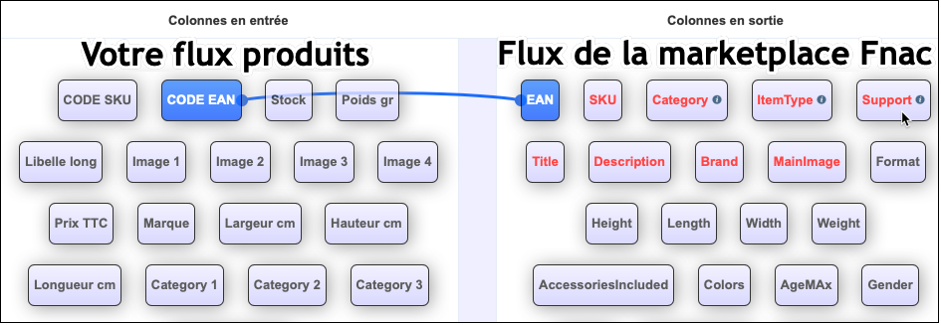
Category mapping rules
This type of rule is used to recategorize the products of the feed. Here, Fnac has a “Multi-activity Swings / Gantry” category.

Complex mapping rules
This type of rule is used to transform the content of the feed. Here for example, the rule removes the HTML code from the description, because HTML is prohibited on the FNAC marketplace. Many transformations are possible: “find – replace”, “remove”, “concatenate”, “add” etc. At Sellermania, our feed management solution is equipped with more than 50 functions that allow you to transform your product feed in depth, and adapt to all situations.

This work of rules is done on the feed manager platform and only needs to be done once. Once completed, the creation of product sheets will be automated and the files created will be referenced automatically in the corresponding categories on each of the marketplaces, ready for sale.
The models vary according to the managers or aggregators of marketplace flows. Most solutions charge a price based on the number of products indexed in the feed that starts around € 150 per month.
Some solutions add a commission on sales.
At Sellermania, the software depends on the options chosen, and starts from € 149 per month, without commissions, depending on the features chosen in the software.
First on your e-commerce site
Like all software added to your site, you must download the module of your feed manager . You must check that it is compatible with the version of your site (ex: Prestashop 1.6). Then, there are operations specific to the module to be configured (eg: identification code to be retrieved from your manager) and the setting up of your preferences in the module (eg: display).
Then on the platform of your feed manager
This is where you set up your flow, and optimize it using mapping rules, category rules, and various management rules. An e-commerce feed management solution like that of Sellermania allows you to preview the feed before distributing it, to have an overview of errors to correct them upstream. For example, you can do a test on a single product, and make sure that your feed is correctly configured, before broadcasting your entire feed.
A feed manager allows you to:
- Distribute your product catalogue on multiple sales channels, in order to increase your online presence.
- Centralize the orders you place on marketplaces in order to facilitate their management
The marketplaces feed manager is used by e-merchants who wish to simplify the sale on several channels, by centralizing the activity. It allows them to export product feeds from their e-commerce site efficiently, without having to interface with each channel. This saves them time, and is more efficient.
Your product catalogue generally comes from an e-commerce site (Prestashop, Magento, Drupal, Woocommerce, proprietary site, etc.), an ERP, a PIM, or a simple Excel file.
It contains all your references, with two types of information: product information, which describes the item sold, regardless of the merchant, and offer information, merchant specific, which describes the sale price, stock, the delay etc.
Descriptive information of the products:
- EAN code
- Title
- Mark
- Description
- Image link
- Category
- Keywords
- Specific attributes used to describe the article
- etc.
Offer information:
- Quantity in stock
- Selling price
- Delivery time
- Terms of delivery
- etc.
In red, product information, and in green, offer information:
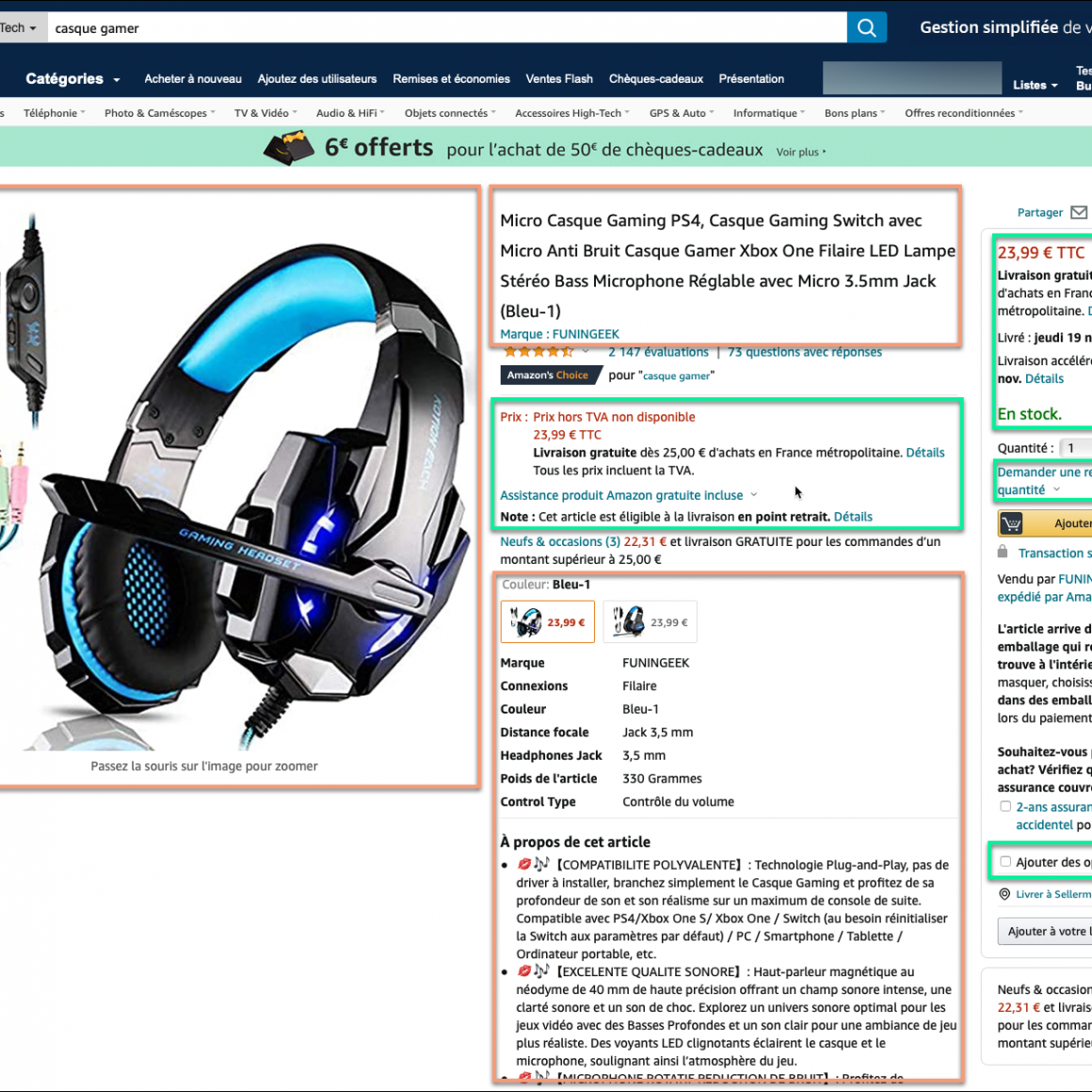
It is important that product information and offer information are clearly distinguished. Shipping costs should not be found in item descriptions, or your website address on product images. The descriptive information of the products will be used to create article sheets on the marketplaces sites, and they must therefore be independent of your offer information, and be content to describe the items sold.
Some marketplaces require a relatively high level of detail to describe items, multiplying attributes such as length, weight, gender, colour, etc. It can quickly become complicated if the product feed does not contain enough information to fill these attributes. Likewise, if this information is not easily identifiable in the product flow, because it is mixed in the description of the items, for example, this makes the integration complex.
The richer the product flow, the easier the integration into marketplaces will be.
The format of the file itself, whether CSV or XML, is usually of little importance, although often CSV is more convenient.
Learn more about optimizing your Marketplaces sales
Our clients’ opinions
-
Would recommend to a friend
-
Are satisfied or very satisfied
-
Increase their turnover
-
Save time
